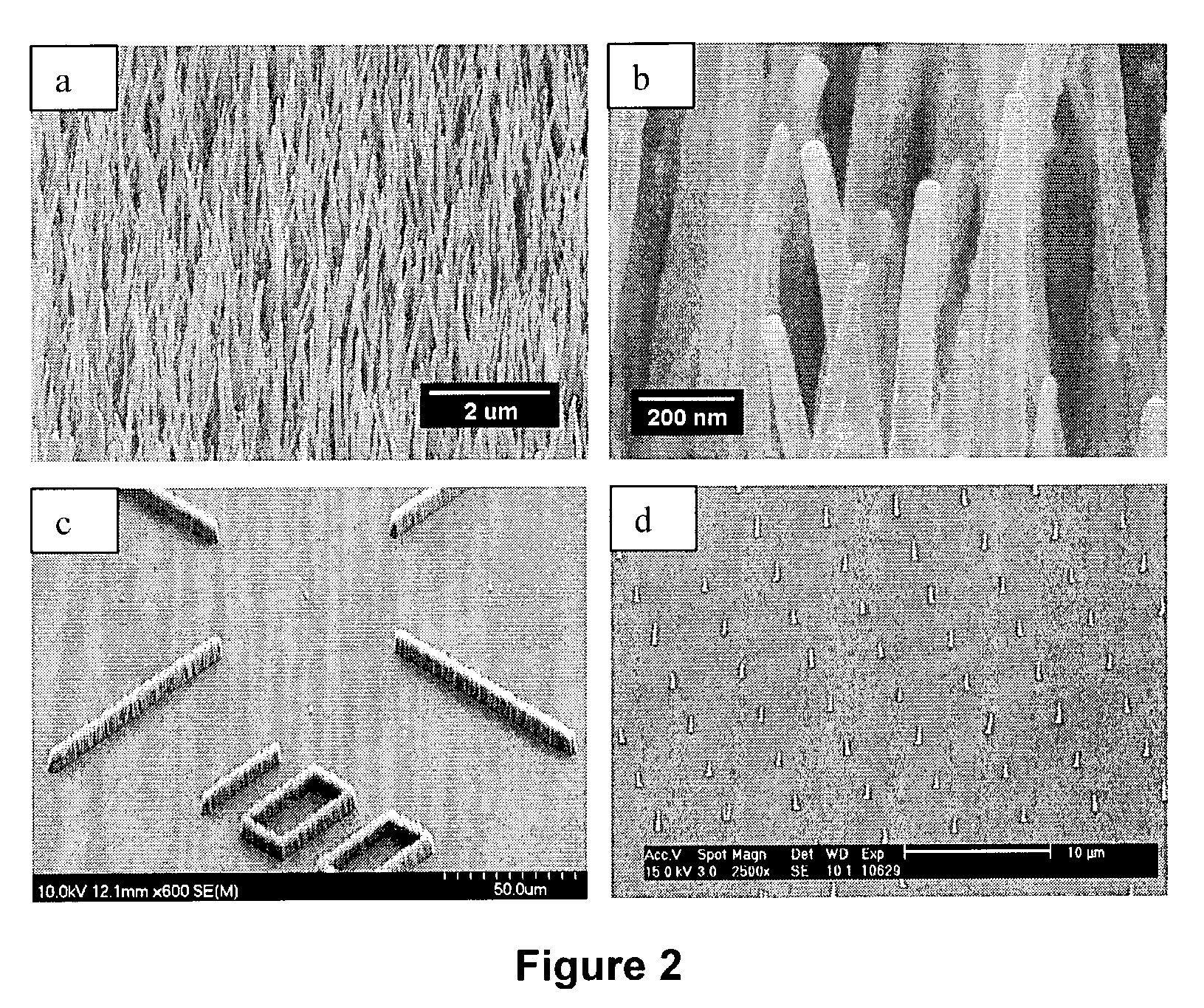Nanoengineered membranes for controlled transport
a technology of controlled transport and nanoengineered membranes, applied in the direction of catalyst activation/preparation, metal/metal-oxide/metal-hydroxide catalysts, chemical/physical processes, etc., can solve the problems of significant concentration difference, significant challenge and opportunity, and significant challenges, and achieve the effect of printing on even smaller scales
- Summary
- Abstract
- Description
- Claims
- Application Information
AI Technical Summary
Benefits of technology
Problems solved by technology
Method used
Image
Examples
example 1
Synthesis of Deterministically Grown Carbon Nanofibers
[0060]The inventors of the present application have developed methods for catalytically controlled growth of vertically aligned (i.e., perpendicular to the substrate surface), multi-walled carbon nanofibers (see Merkulov et al. articles referenced above). The basic process utilizes plasma-enhanced chemical vapor deposition (PE-CVD) in conjunction with E-beam lithography for the precise placement of evaporated and size-controlled catalyst-metal dots. A mixture of acetylene (C2H2) and ammonia (NH3) is used as a source gas during the PE-CVD process. The substrate is heated above approximately 600° C. After the plasma is turned on, carbon nanofibers grow selectively at the locations where catalyst dots (Ni, Fe, Co) were pre-deposited. The procedure is outlined in FIG. 1, and Example 5 below describes one method that has been used to produce vertically aligned multi-walled carbon nanofibers. This method is similar to the hot-filament ...
example 1a
[0061]Examples of carbon nanofibers grown from lithographically defined catalyst dots are shown in FIG. 2. FIGS. 2a-c shows images of carbon nanofibers (CNFs) grown as “chaotic forests”. The CNFs were grown from catalytic metal particles that are randomly distributed on the surface. The metal particles are seen at the tips of the fibers in FIGS. 2a and b. After growth of the fibers, these catalytic particles can also be removed.
[0062]When VACNFs are grown chaotically, there is less control of the relative location of catalyst nanoparticles, or the size of the particles. However, these chaotic forests of VACNFs can be grown in lithographically defined areas as seen in FIG. 2c. Alternatively, VACNFs can be prepared in a completely deterministic fashion by precise patterning of the catalyst metal particle. In this approach, the patterning of the particles determines the VACNF location, the size of the catalyst particle defines the diameter of the VACNF, and growth time determines the l...
example 2
Fabrication of Addressable Electrochemical Nanofiber Probe Arrays
[0063]A fabrication technique has been developed that provides multielement nanoscale probing arrays with each fiber element featuring independent addressability, and an exposed electrochemically active tip of approximately 20-30 nanometer diameter (FIG. 4) (See Guillorn et al., “Individually addressable vertically aligned carbon nanofiber-based electrochemical probes”, J. Appl. Phys., 91(6), 3824-3828, 2002). These devices may be fabricated on traditional Si wafers, or upon quartz wafers, facilitating their use upon fluorescent microscopy platforms. Tungsten interconnects provide wirebond connectivity to individual elements of fibers that are deterministically grown at the opposing terminus of tungsten leads. The entire structure (interconnects and fiber sheath) is passivated with a high-quality oxide, such that electrochemical activity is limited to only the extreme exposed tip of each fiber element. These native car...
PUM
| Property | Measurement | Unit |
|---|---|---|
| width | aaaaa | aaaaa |
| diameters | aaaaa | aaaaa |
| length | aaaaa | aaaaa |
Abstract
Description
Claims
Application Information
 Login to View More
Login to View More - R&D
- Intellectual Property
- Life Sciences
- Materials
- Tech Scout
- Unparalleled Data Quality
- Higher Quality Content
- 60% Fewer Hallucinations
Browse by: Latest US Patents, China's latest patents, Technical Efficacy Thesaurus, Application Domain, Technology Topic, Popular Technical Reports.
© 2025 PatSnap. All rights reserved.Legal|Privacy policy|Modern Slavery Act Transparency Statement|Sitemap|About US| Contact US: help@patsnap.com



